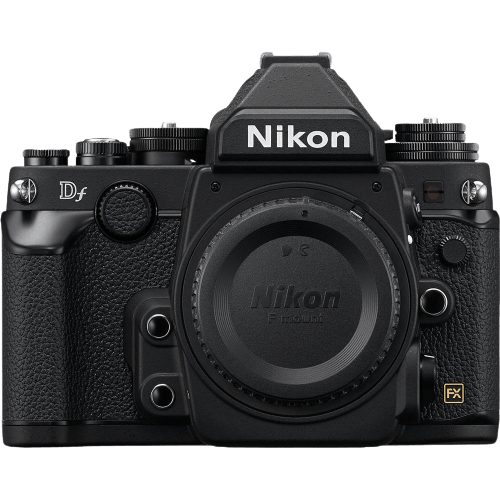Nikon Df Specs and Scores

The Nikon Df scores 58/100 in our evaluation, which is a decent rating considering its age. Announced in November 2013, this DSLR camera was launched at a price of $2749. The camera measures 144 x 110 x 67mm and weighs 1.68lbs (760g), making it compact and lightweight.
Although the Nikon Df is not the latest camera on the market, its specifications still hold up fairly well. For those seeking a reliable and user-friendly DSLR, this camera remains a solid option.
Nikon Df Overview and Optics
The Nikon Df’s optics score stands at 60/100. With 16.2 megapixels, this camera has a decent resolution, though not the highest in today’s market. The shooting speed reaches 5.5 frames per second, which is adequate for most photography needs. The camera features a CMOS sensor, paired with the Expeed 3 processor, resulting in a DXOMARK score of 89 for the sensor. This score shows that the Nikon Df is a reliable option for image quality.
The full-frame sensor size ensures optimal performance in low light conditions and provides a shallow depth of field. The Nikon F FX lens mount offers compatibility with a wide range of lenses, allowing users to expand their photography skills. However, the camera lacks image stabilization, which may require additional equipment for steady shots. The 3:2 aspect ratio is standard for most DSLR cameras.
The Nikon Df’s optics, while not top-of-the-line, provide satisfactory results for many photographers. Its compatibility with various lenses and decent image quality make it a suitable choice for those seeking a reliable camera without the highest specifications.
Nikon Df Video Performance
The Nikon Df lacks video capabilities. This camera focuses on photography only, not offering any video recording features.
Nikon Df Features and Benefits
The Nikon Df’s features score is 57 out of 100. This camera has a 3.2-inch screen with a resolution of 921,000 dots. Unfortunately, it lacks modern features such as a touchscreen, flip screen, GPS, WiFi, and Bluetooth capabilities.
When evaluating these specifications in today’s market, the Nikon Df falls short in comparison to newer models with more advanced features. The absence of a touchscreen and flip screen limits the usability and versatility of this camera. Additionally, the lack of GPS, WiFi, and Bluetooth functions restricts connectivity options and convenience for photographers.
Taking these factors into account, the Nikon Df’s features may not be as competitive as those found in contemporary camera models. While it may still be a decent option for photographers who value simplicity and a classic design, its limitations should be considered before making a purchase decision.
Nikon Df Storage and Battery
The Nikon Df receives a storage and battery score of 48 out of 100. This camera has a single memory card slot, accepting SD, SDHC, and SDXC cards. Compared to other cameras on the market, having only one memory card slot may be limiting for some users, especially professionals who require backup storage.
The battery life of the Nikon Df is 1400 shots per charge, using the EN-EL14 battery type. This battery life is quite impressive and provides adequate shooting time for most situations. However, the camera lacks USB charging, which is a disadvantage in today’s market, where convenience and portability are essential.
Taking these specifications into account, the Nikon Df offers a decent battery life but falls short in storage options and charging convenience. While it may not be the top choice for those prioritizing storage and battery features, it remains a solid camera in other aspects.
